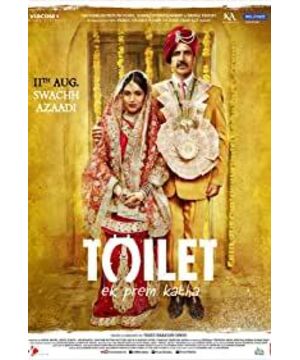My first impression of the toilet hero is: too much like an Indian partner.
Both films use a relatively detailed and somewhat embarrassing topic as a breakthrough, opening up the contradictions in India on issues such as equality between men and women, cultural beliefs and modernization, etc., and then start the plot. However, from the rhythm of the plot, the mashup of elements, and the logic and rationality of the plot deduction, including the choice and choice of love, the level of the toilet hero and the Indian partner is too different.
Song, dance and love are standard in Indian films. In the two films, these two elements are treated differently.
In Indian partners, the ratio of love and main plot is just right. The main creator did not give too much space to the love scene, but the plot promotion of the film is always linked to the love element. Love is the adjustment of the main line. It did not steal the limelight of the main line. At the same time, it also showed the tender side of the male protagonist. Especially when he faced the choice between the two girls and finally made the choice to return to the family, it was very meaningful. And in Toilet Heroes, the relationship between love and the main line feels a little weird.
At the beginning, the male protagonist's pursuit of the female protagonist had nothing to do with the main line, but it actually took nearly half of the film's length. On the first day of the heroine's marriage to the hero, the main storyline has just begun. Later, when promoting the conflicting plot caused by the toilet incident, the main creator adopted a bizarre setting in which two people love each other, but they had to get married, which made people feel very uncomfortable, incomprehensible, and no resonance
Although the length of the love drama is relatively large, it is relatively lacking in matching. The enchanting, singing, dancing and interludes of the Indian partner are all shot in real locations, and are completely seamlessly connected to the plot. Among them, the joy of marriage, the excitement of newly married, the melancholy of separation, and the joy of success are all well expressed. The songs and dances in Toilet Hero are mostly expressed in the form of episodes. Except for the wonderful song and dance scene in the Holi Festival, nothing left a lot of impression on people.
The core goal of the film is to use an indescribable breakthrough to criticize the stubborn thinking of the Indian countryside that has been clinging to tradition and abandoning modernization for many years. This is a very good way of saying it in itself, but the answers given by Indian partners and toilet heroes are very different.
Among the Indian partners, the ostensible reason for Indian women not to use sanitary pads is the disrespect of men to women. The deep-seated reason is that women who cannot generate direct income cannot obtain a status that matches that of men, that is, economic ability determines social status. Therefore, the male protagonist's approach is to extensively develop women's agents. On the one hand, they sell pad products, and on the other hand, they give them the ability to make money, and fundamentally solve the problem of equal rights between men and women. Although there may be some problems with actual implementation, I think this is the fundamental way to achieve equality.
Among toilet heroes, the toilet problem is not linked to economics, but to cultural beliefs. Although there is no major problem with the direction, the handling method is more uncomfortable. As the film says, using the toilet actually goes against local religious theories and teachings. But this contradiction, fundamentally speaking, is not equal rights for men and women. Or the contradiction of religious freedom, but the contradiction between modernization and tradition. rather than a conflict of equality between men and women.
In the second half of the film's description of the toilet issue, it links toilets with equal rights for men and women, without mentioning any modernization issues, and strives to disregard the responsibility of local officials for their inaction in this turmoil. . . This is a bit of a nonsense with your eyes open.
From the perspective of a small family, the stubborn father finally accepted the idea of his daughter-in-law building a toilet at home. This plot also makes people feel a bit nonsense. It's hard to imagine how a stubborn old man who has been stubborn for decades can change his ideas so quickly because of an extremely accidental event.
Overall, this video:
The first third of the plot has nothing to do with the main line;
The middle third begins to develop the main plot and contradictions;
And just when we were thinking hard about how to solve the dead end of the male protagonist, the last third of the plot gave the male protagonist countless bug-level props, allowing him to easily deal with the government, stubborn father.
The consequence of this is that the quality of the film has taken a nosedive. In the end, I even think that the so-called struggle between men and women, even at the expense of divorce, to awaken the so-called public consciousness is really meaningless, or even a farce.
After all, you are only solving a toilet problem.
View more about Toilet: A Love Story reviews











